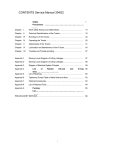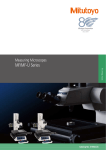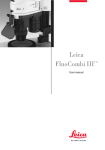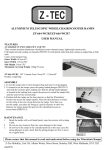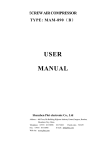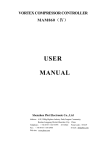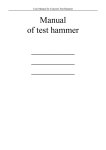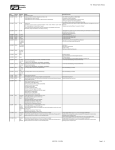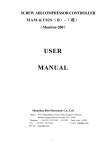Download SYS Automatic Hydro Pressure Testing Machine
Transcript
SYS Automatic Hydro Pressure Testing Machine User’s Manual Shanghai Kaishen Technique Service Co., Ltd Ⅰ. Overview of Principle and Sructure The hydro pressure-testing machine is a set of devices used to test the interior pressure of the fire extinguisher (or the gas cartridge), and measure the ratio of permanent volumetric expansion of the cylinder through the interior pressurization test. It mainly comprises of an electric pressure test pump and an electric control device. This machine has the advantages of mobility. The motor and reduction gearbox are installed on the water tank cap. Worm-wheel type reduction gearbox, and worm drive. The velocity ratio is 2:45. And there is an eccentric shaft on each side of the worm wheel, and they are 180º to each other. With the slider and crosshead inside the outer transmission gearboxes on both the side caps, they convert the rotary motion into reciprocating type rectilinear motion so as to achieve the alternative inhaling and disgorging process of the pump. There is a 60Mpa pressure gauge with electric contacts installed on the top of the testing pump to set the controlled pressure arbitrarily. When the discharge pressure reaches the testing pressure, the pressure with electric contacts will send out signals, and the power of the motor will be switched off automatically. The record of the burette will reflect if the cylinder meets the requirements of the pressure testing. Above the machine case handle, there is an electric control device, which has a startup button (green) and a stop button (red), by which you can control the operation of the testing pump manually. And there are fuses, AC contactors, etc. in the case. Ⅱ. Technical Parameters 1. Type: Volume: Weight: Quantity of Flow: Power: Rated Discharge Pressure: 2. Type: Volume: Weight: Quantity of Flow: Power: Rated Discharge Pressure: Voltage: 4DY-30/40 805×480×1210 mm 230Kg 30 at high pressure, 360 at low pressure (L/H) 1.5KW 25mpa 4DY-1 Type 46/63 740×370×1140 mm 158Kg 146 at high pressure, 320 at low pressure (L/H) 1.1KW 6.3mpa AC220V, AC380V, 50Hz Ⅲ. Schematic Diagram of Structure and Pipeline Note: 1.Relief Valve 2. Pressure Gauge 3. Pressure Gauge with Electric Contacts 5. Button (Off) 6. Glass Burette 7. Container to be Tested 4. Button (On) Ⅳ. Installation and Operation 1. Preparation work before operation (1) The reduction gearbox should be filled with lubricating oil, if not, you can add black gear oil (SYB1103-625) through the fluid level screw; (2) Add No.30 machinery oils (GB443-64) to the transmission case and the oil level should never exceed the guide rail surface under the crosshead. You can also add lubricating oil to the tank through the oil tablet periodically, and make sure that there will be oil dripping to the transmission case during operation. The burette should be fastened vertically; (3) You should open the relief valve before operation, and turn on the power to operate the pump under normal pressure. If there is no abnormal sound or retardation, and water filling of the intake pipe is regular, you can stop water filling, turn off the power and keep the relief valve open. Now you can test the pressure, and the cylinder to be tested should be filled with water before testing. 2. Operation Steps (1) Install the cylinder to be tested, clamp the fire extinguisher cylinder to be tested with the dedicated clamp (leave some air gap for exhausting) to make it connected with the hydraulic pressure machine, and you should press and keep the push button on the cylinder; (2) Exhaust: Press the startup button to operate the electric pressure-testing pump. The air is considered to be all discharged when water begins to flow out through the gap, close the relief valve and clamp the dedicated clamp; (3) Leakage checking: Keep the pump on operation, when the readout on the pressure gauge reaches the preset working pressure, the electric pressure testing pump will stop automatically. If the pointer of the pressure gauge rotates slowly, the pressure decreases. It means that there is leakage on the cylinder to be tested. You should open the relief slowly to relieve the pressure. Record the leakage and stop testing this cylinder; (4) Increase the pressure: Close the relief valve. Adjust the water surface in the burette with the intake switch until it aligns with the scale mark. Turn on the pressure testing pump, when the readout of the pressure gauge reaches the testing pressure of the cylinder to be tested, the pump will automatically stops; (5) Maintain the pressure: If the readout of the pressure gauge drops during the period of maintaining the pressure, it should be recorded. When the specified time of maintaining the pressure elapses, record the scale value of the water surface in the burette. This value is the total water volume (A) pumped into the cylinder; (6) Relieve the pressure: Open the relief valve. It should be noted that you should relieve the pressure slowly, and carefully observe if there is any air bubble emerges in the burette. If there is, this test is considered to be invalid. When the readout of the pressure gauge returns to “Zero”, record the scale value of the water surface in the burette (B is the volume of the backwater). This value is the volume of the cylinder to be tested, the value of residual deformation △V1. (7) Calculation: A – Volume of intake water (the volume of the water added) B – Volume of backwater (the volume of the backwater after relieving the pressure) Residual Ratio = A− B ≤ 6% A Ⅴ. Common Troubles and Ways of Troubleshooting If there are troubles during pressure testing, you should firstly correct troubles such as leakages on pipeline, leakages on the devices to be tested; then find troubles on the automatic hydro pressure machine and correct them. Trouble Symptom Cause Ways of Troubleshooting The pressure of the pump 1. The filter screen is blocked or increases too slowly or the connector leaks; 2. The ingress and egress valves doesn’t increase. are not sealed or fixed; 3. The plunger seal rings is loosened or damaged. The period of maintaining 1. The valve on the the pressure of the pump is collector leaks; too short, or it cannot reach 2. The safety valve leaks; 3. The connector leaks. the rated testing pressure. Wash and clean the dirt, tighten the connector; Remove and check it, clean, grind or replace it; Adjust the push turnbuckle or replace the seal ring. water Tighten or replace the valve; Adjust the spring or clean the seal surface; Tighten the connector or replace the seal gasket. The temperature of the 1. The lubricating oil is not reduction gearbox is too adequate, or it is too much or high. too dirty; 2. The safety valve is heavy-footed or the pump is overloaded; 3. The worm wheels are not in good engagement. Replace or adjust the lubricating oil; The motor is overloaded. Avoid overload; Add or replace lubricating oil. 1.The pump is overloaded; 2. There is not any good lubrication; 3. The voltage of the power is too low; 4. The plunger seal ring is too tight. Avoid overloading or examine and repair the safety valve; Check the contact surface, and adjust the position of the worm wheel. Increase the voltage of the power. Adequately loosen the push turnbuckle. Ⅵ. Maintenance and Repair 1. The outer surface of the pump, the lubricating oil in the reduction gearbox and transmission case and the water used should be kept clean and free of dirt or sundries; 2. The lubricating oil that is used for the first time in a new pump should be replaced after 60 working hours, and at intervals of about 500 hours afterward; 3. Pumps that will not be used for a long time should be treated with preservatives. Drain out the water and daub the antirust oil on the components without paint, and the outer surface should be painted with machine oil for rust proof; 4. If the speed of pressure increasing is abnormal during the pressure increasing process, you should immediately stop the test, try to find the cause of it and correct it; 5. When the pressure of the cylinder to tested is over the rated pressure, the cylinder should never be impacted and shocked. 6. The pressure should decrease slowly during pressure relieving. Shanghai Kaishen Technique Service Co., Ltd






